
Ralph Waldo Emerson, who went by his middle name Waldo, was an American essayist, lecturer, philosopher, and poet who led the transcendentalist movement of the mid-19th century. He was seen as a champion of individualism and a prescient critic of the countervailing pressures of society, and he disseminated his thoughts through dozens of published essays and more than 1,500 public lectures across the United States.
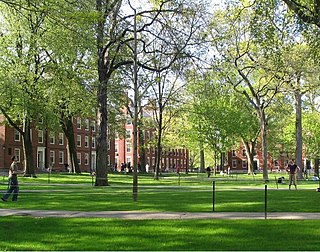
Harvard Yard, in Cambridge, Massachusetts, is the oldest part of the Harvard University campus, its historic center and modern crossroads. It contains most of the freshman dormitories, Harvard's most important libraries, Memorial Church, several classroom and departmental buildings, and the offices of senior University officials including the President of Harvard University.

Benjamin Wadsworth was a colonial American clergyman and educator. He was trained at Harvard College. He served as minister of the First Church in Boston; and as president of Harvard from 1725 until his death.

Harvard Divinity School (HDS) is one of the constituent schools of Harvard University in Cambridge, Massachusetts. The school's mission is to educate its students either in the academic study of religion or for leadership roles in religion, government, and service. It also caters to students from other Harvard schools that are interested in the former field. HDS is among a small group of university-based, non-denominational divinity schools in the United States.

Frederic Henry Hedge was a New England Unitarian minister and Transcendentalist. He was a founder of the Transcendental Club, originally called Hedge's Club, and active in the development of Transcendentalism. He was one of the foremost scholars of German literature in the United States.

Andrews Norton was an American preacher and theologian. Along with William Ellery Channing, he was the leader of mainstream Unitarianism of the early and middle 19th century, and was known as the "Unitarian Pope". He was the father of the writer Charles Eliot Norton.
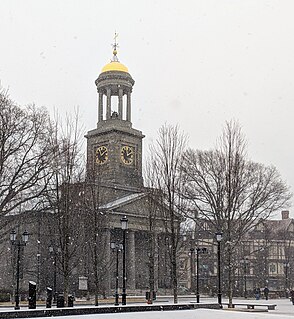
United First Parish Church is a Unitarian Universalist congregation in Quincy, Massachusetts, established as the parish church of Quincy in 1639. The current building was constructed in 1828 by noted Boston stonecutter Abner Joy to designs by Alexander Parris. The building was designated a National Historic Landmark on December 30, 1970, for its association with the Adams family, who funded its construction and whose most significant members are interred here.

Massachusetts Hall is the oldest surviving building at Harvard College, the first institution of higher learning in the British colonies in America, and second oldest academic building in the United States after the Wren Building at the College of William & Mary. As such, it possesses great significance not only in the history of American education but also in the story of the developing English Colonies of the 18th century. Massachusetts Hall was designed by Harvard Presidents John Leverett and his successor Benjamin Wadsworth. It was erected between 1718 and 1720 in Harvard Yard. It was originally a dormitory containing 32 chambers and 64 small private studies for the 64 students it was designed to house. During the siege of Boston, 640 American soldiers took quarters in the hall. Much of the interior woodwork and hardware, including brass doorknobs, disappeared at this time.
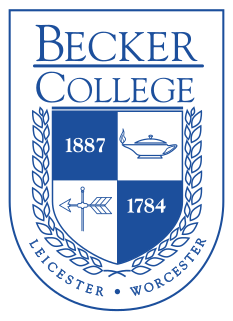
Becker College is a college in central Massachusetts, United States, with campuses in Worcester and Leicester. Becker College traces its history from the union of two Massachusetts educational institutions—one founded in 1784 and the other in 1887. The college offers more than 40 undergraduate degree programs including nursing programs, a veterinary science program, and video game design and development programs. The college's 2016-17 enrollment was 1,892. Becker College has more than 21,000 alumni.

The "Divinity School Address" is the common name for the speech Ralph Waldo Emerson gave to the graduating class of Harvard Divinity School on July 15, 1838.
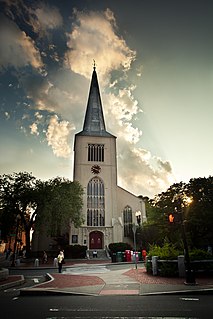
First Parish in Cambridge is a Unitarian Universalist church, located in Harvard Square in Cambridge, Massachusetts. It is a Welcoming Congregation and a member of the Unitarian Universalist Association. The church is notable for its almost 400-year history, which includes pivotal roles in the development of the early Massachusetts government, the creation of Harvard College, and the refinement of current liberal religious thought.

Jones Very was an American poet, essayist, clergyman, and mystic associated with the American Transcendentalism movement. He was known as a scholar of William Shakespeare and many of his poems were Shakespearean sonnets. He was well-known and respected amongst the Transcendentalists, though he had a mental breakdown early in his career.

Sever Hall is an academic building at Harvard University designed by the American architect H. H. Richardson and built in the late 1870s. It is located in Harvard Yard in Cambridge, Massachusetts. It was designated a National Historic Landmark in 1970, recognized as one of Richardson's mature masterpieces.

The Ralph Waldo Emerson House is a house museum located at 18 Cambridge Turnpike, Concord, Massachusetts, and a National Historic Landmark for its associations with American philosopher Ralph Waldo Emerson. He and his family named the home Bush. The museum is open mid-April to mid-October; an admission fee is charged.
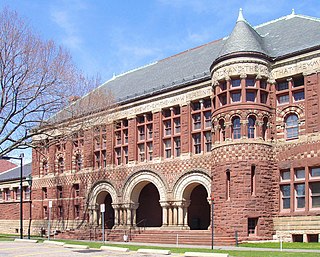
Austin Hall is a classroom building of the Harvard Law School designed by noted American architect H. H. Richardson. The first building purposely built for an American law school, it was also the first dedicated home of Harvard Law School. It is located on the Harvard University campus in Cambridge, Massachusetts, and was listed on the National Register of Historic Places in 1972.

The West Newton Village Center Historic District encompasses the heart of the village of West Newton, in the city of Newton, Massachusetts in the United States. It extends along Washington Street between Lucas Court in the west and Davis Court in the east, and includes a few properties on immediately adjacent side streets, including Watertown Street and Waltham Street. The village is the second-largest of Newton's commercial centers and is the best-preserved of its late 19th and early 20th century village centers. The district was listed on the National Register of Historic Places in 1990.
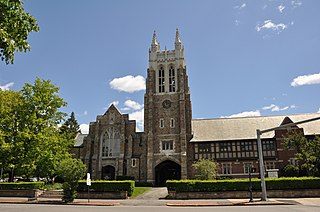
The First Unitarian Universalist Society in Newton occupies a prominent location at 1326 Washington Street in the heart of the village of West Newton in Newton, Massachusetts. Architect Ralph Adams Cram designed the church, Frederick Law Olmsted, Jr. designed the grounds, the cornerstone was laid in 1905, and it was dedicated in 1906; it is one of the village's oldest buildings. The church is in Cram's signature Gothic Revival style, with buttressed walls and a blocky square tower with crenellations and spires. An enclosed courtyard is formed by an office wing, banquet hall, and parish house, which are built to resemble Elizabethan architecture with brick first floor and half-timbered upper level.
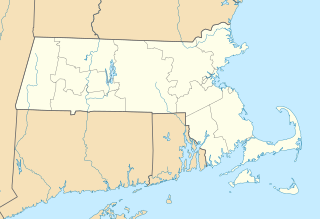
The Ames Schoolhouse is a historic school building at 450 Washington Street in Dedham, Massachusetts. It was originally part of the Dedham Public Schools. It currently serves as the town hall and senior center for the Town of Dedham.
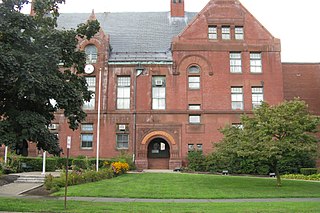
Westfield Municipal Building is a historic building at 59 Court Street in Westfield, Massachusetts. It presently houses the Westfield city offices and the local district court. It was built in 1889 to house the state normal school, serving in that role until its acquisition by the city in 1959. The building was designed by the architectural firm of Hartwell and Richardson. The second partner was William Cummings Richardson, not H. H. Richardson, but the design of this building, only a few years after the latter's death, was strongly influenced by his distinctive style.
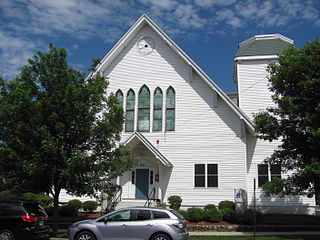
The First Unitarian Church is a historic former church building in Stoneham, Massachusetts. One of Stoneham's more stylish Gothic Revival buildings, the Stick style wood structure was built in 1869 for a Unitarian congregation that was organized in 1858. The building was listed on the National Register of Historic Places in 1984, and included in the Central Square Historic District in 1990. It presently houses the local Community Access Television organization.























